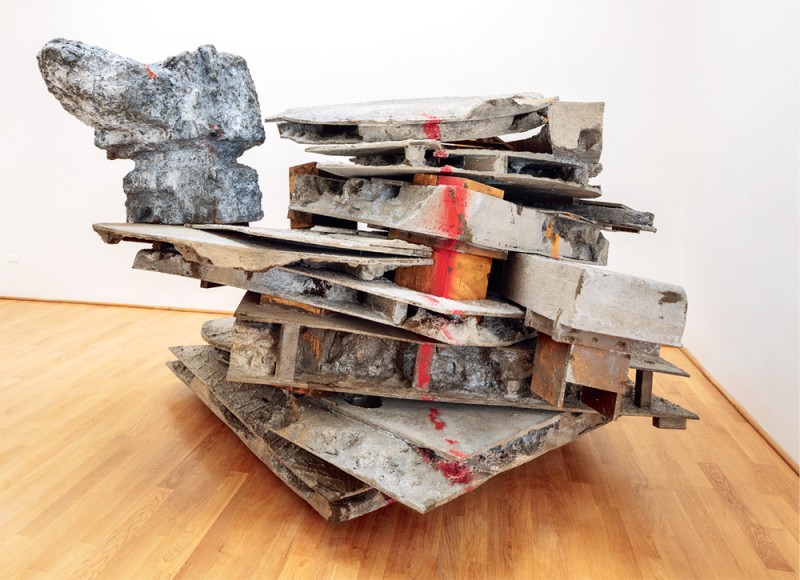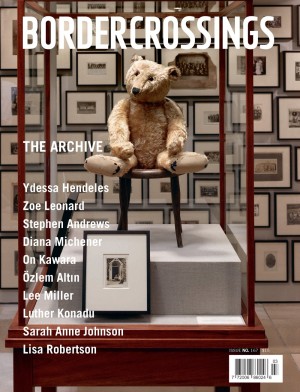All Sorts of Things That Are Bigger Than Myself
The Sculptural World of Phyllida Barlow
Phyllida Barlow is a material magician, the consummate alchemist of stuff. She is able to take the most unimpressive things—plaster, foam, PVA, chicken wire, cardboard, sand, polyurethane, lumber, rubber cable, paper, clay and the occasional ironing board or television set—and transform them into objects and environments of irresistible charm, depth and beauty. It’s as if she convinces and cajoles them into being better than they are.
I’m anthropomorphizing her materials because she herself appreciates their liveliness. She talks about what happens to things as they participate “in the adventure of objects,” and how adventure is at the centre of her sculptural production. She regards the world of objects and things in which she moves with a sense of pragmatic wonder, and she admits her attraction to “the incongruous, the out-of-synch or to something that doesn’t quite fit.”

Installation view, “Phyllida Barlow: Cast,” 2011, Kunstverein Nürnberg, Nuremberg, Germany. Photo: Stephan Minx. 59291txt.
What is immediately apparent in looking at her sculpture, whether individual pieces or clusters that take the form of an installation, is the focus on a particular kind of visual theatre in which the objects perform in the space as much as they occupy it. This sense of theatre is most evident in her large-scale exhibitions, like “Brink” at the Ludwig Forum in Aachen in 2012, “TIP” at the Carnegie Museum of Art in 2013, “dock” at Tate Britain in 2014 and “folly” at the Venice Biennale in 2017. In Pittsburgh, London and Venice, Barlow made work commensurate with the architecture she was inhabiting. Her crowd of sentinel-objects in “TIP” weren’t only in the gallery but outside of it; the grounds, staircase and entranceway to the British Pavilion in Venice were populated by a constellation of “baubles”; and her hung “blocks and “lumps” commandeered the vaulted ceilings of the magisterial Duveen Galleries. In each instance sculpture and space co-existed in a brilliantly uneasy relationship.
In the following interview she says that what she cherishes about sculpture “is its obduracy and its relationship to action.” One of her consistent recognitions has been the idea that her sculpture invites an active engagement between viewer and viewed. The word that continually comes up in her conversation is “encounter,” and it is framed within the form of drama. As she articulates it, the drama is a kind of Manichean meeting between art and audience. “To me, viewers always become protagonists on equal footing with the sculptures they are looking at,” she says. Which makes her the director, playing out the chanced encounters between the characters of her balconies, hoardings, stockades, leaning fences and stacked pianos, and those of us she calls “the audience, the other protagonists, the other performers.” The shift in our role from protagonist to performer is a significant one. The protagonist can hold to an attitude of stubborn resistance, but a performer is obliged to go beyond that and to assume an active role, to join the company, as it were. If making sculpture is play and art, and audience are players, then a script becomes a necessary thing. For Barlow, that script is always an activated work-in-progress in which, “even though I’m not sure of the outcome, the outcome will reveal itself.” Her uncompromising commitment is to a process that sees contingent meaning coming out of continuous making.

Installation view, “folly,” 2017, British Pavilion, 57th Venice Biennale, Italy. © British Council. Photo: Ruth Clark. Courtesy the artist and Hauser & Wirth.
Barlow remains productively resolute and resolutely skeptical. She admits to being “suspicious of certainty,” and the scale and quality of her artmaking stand as a profound declaration of her certain ambivalence about the conclusive. “There were many works in Venice that did have a sense of not quite knowing where they were going,” she says approvingly. “That’s my preferred state of working.” What she has been able to accomplish over her remarkable 50-year career is to transform that philosophy of doubting into a methodology of doing.
Phyllida Barlow’s most recent exhibitions in 2018 include “The Most Real Thing” at the New Art Centre in Salisbury, a permanent outdoor installation called Quarry for Jupiter Artland in Edinburgh, “tilt” at Hauser & Wirth in New York, and “cul-de-sac” at the Royal Academy of Arts in London, on from February through June of 2019. She will also give the 13th annual Shenkman Lecture at the University of Guelph on March 20, 2019.
The following interview was conducted by phone to London, UK, on October 17, 2018.
Border Crossings: Have you been surprised at what has happened to your career since your conversion to fame?
Phyllida Barlow: That’s a good way of putting it. Yes, very surprised. My generation didn’t go into art for a career, so there was a very different trajectory from the off. Having a studio and making the work was seen as a triumph in itself. It was a very different time. The pressure now on emerging artists is absolutely ferocious, but I don’t think that I or my husband, who is also an artist, had that kind of pressure. There were other pressures in the ’60s but the idea of having a career in art was not one of them. You evolved, and as you evolved you might be lucky enough to have exhibitions or stumble into something that gave you a profile. It seemed more humdrum, more haphazard than it does now.

untitled: folly; pianostack/anvil; 2016/2017, 2016–17, plywood, timber, paint, spray paint, cardboard, polyurethane board, polystyrene, polyurethane foam, PVA, cement, scrim, 205 x 278 x 340 cm. Installation view, “folly,” 2017, British Pavilion, 57th Venice Biennale, Italy. © British Council. Photo: Ruth Clark. Courtesy the artist and Hauser & Wirth.
You were certainly candid about what you call your love/hate relationship with the tradition of British sculpture, and as a result you were critical of people like Henry Moore and Barbara Hepworth. Was your resistance to that tradition because it was too conventional?
Exactly. A purely formal relationship with both the figure and abstract forms was beginning to be challenged in America and Europe, and I was very attracted to a kind of anti-form language that was emerging across the visual arts. Also, Moore and Hepworth, whose work I love now, seemed to be hanging on to very strong moral attitudes as to what was right and what was wrong and what was good and what was bad. When I was at the Slade, that kind of criticism seemed authoritarian and in some ways punitive. I love form and I love the languages of form, so my rejection of Moore and Hepworth was more about what they stood for as patriarchal and revered rather than because of the actual work itself.
There were certain inflections of minimalism in some of your early work, and you have mentioned the CoBrA artists and Arte Povera. Were you hungrily looking around for alternatives to what you regarded as these worn-out conventions of making sculpture?

untitled: bottle rack_, 2007, bottle rack, wood, paint, plaster, fabric, 150 x 140 x 130 cm. Installation view, “New Sculpture: In the Gallery and Ground,” 2007, New Art Centre, Roche Court, Salisbury, England. © Phyllida Barlow.
Yes, but I don’t think that I was drastically out of synch with those traditions and even those conventions. I think tradition and convention are two very different things, and it is very difficult not to be traditional as a visual artist, or in any creative discipline. The shoulders that we are all standing on go back for millennia, but the conventions are much more about judgment and a moral idea of good and bad and right and wrong, which, of course, is very restricting. Sooner or later those ideals get challenged and then they come tumbling down like a pack of cards. So, for me, it was more about how judgments were made and what was being left out of those judgments. In what way could those measures be established? Usually it was a combination of skill not being used properly and also the content and the materials not being employed within accepted ways of working. I was able to grasp that I could still use those materials, like plaster and clay, but I didn’t have to obey 19th-century methods for how to work with them. You could invent with the great sculpture skills—carving, casting, clay modelling, armature building—all those disciplines that are invaluable but that don’t have to come with a bag of rules. You can make up how you want to use them, or abuse them.
…to continue reading the interview with Phyllida Barlow, order a copy of Issue #148, or SUBSCRIBE today!

